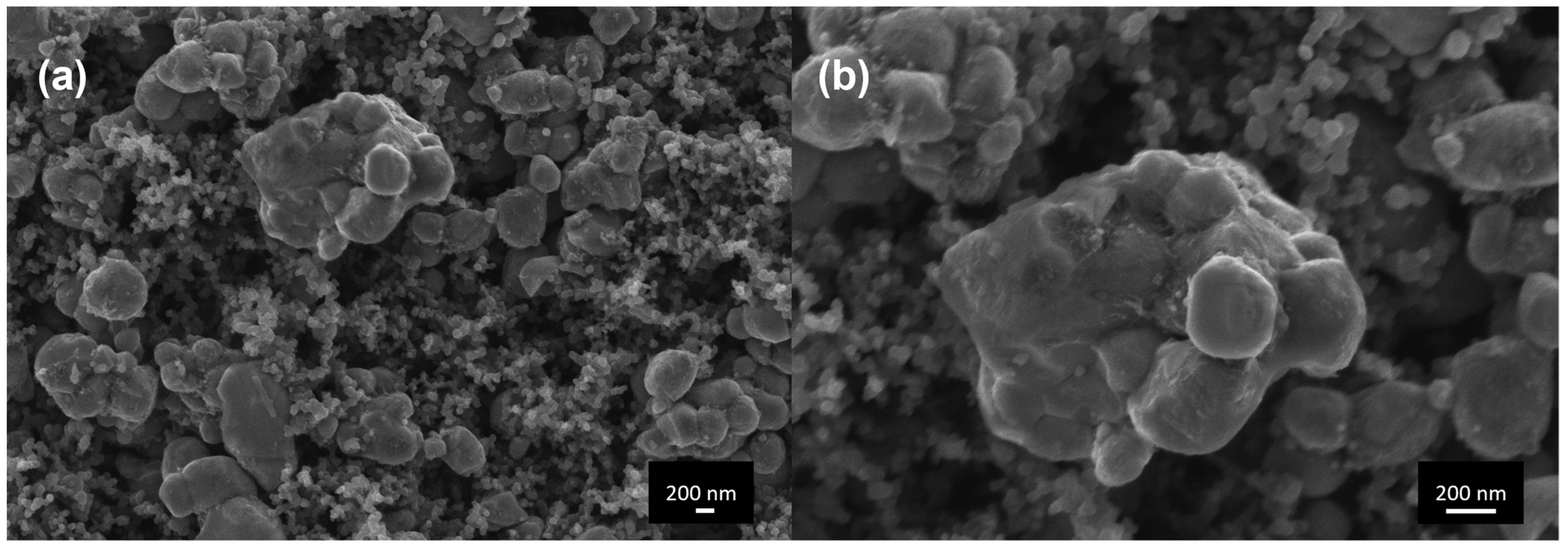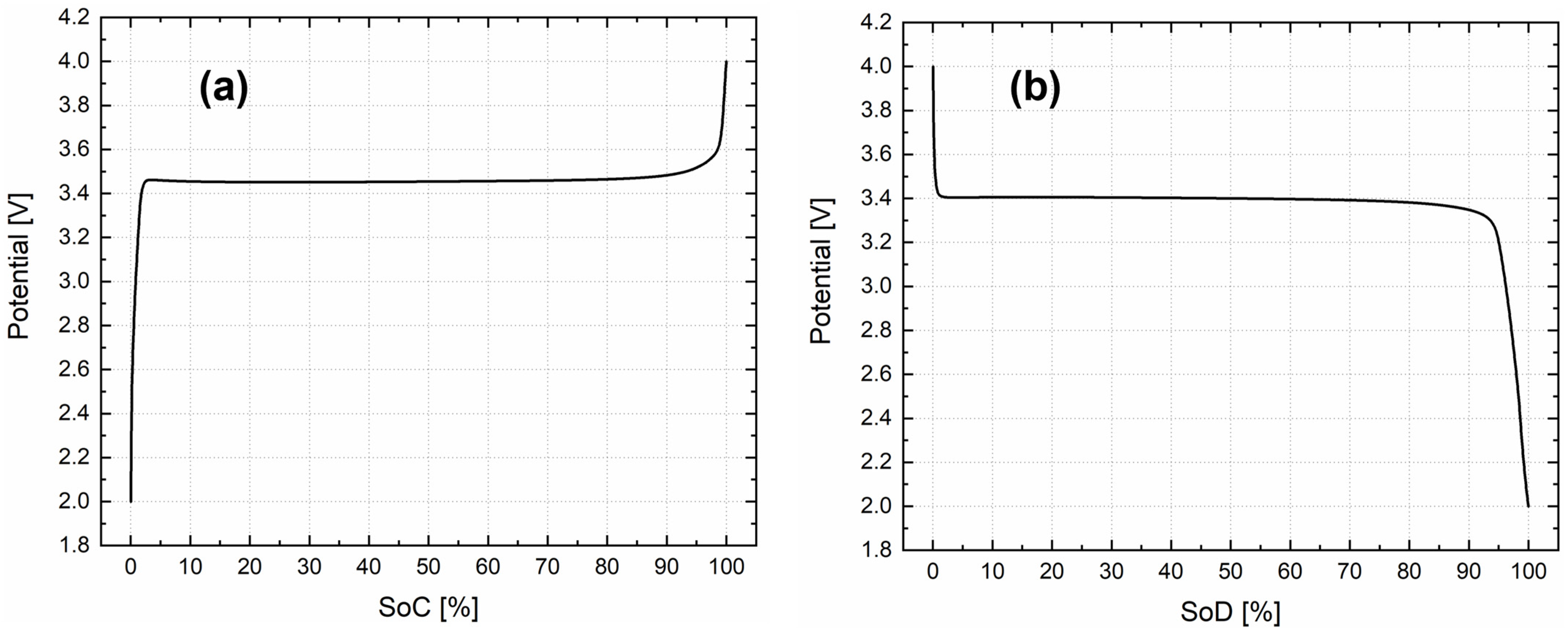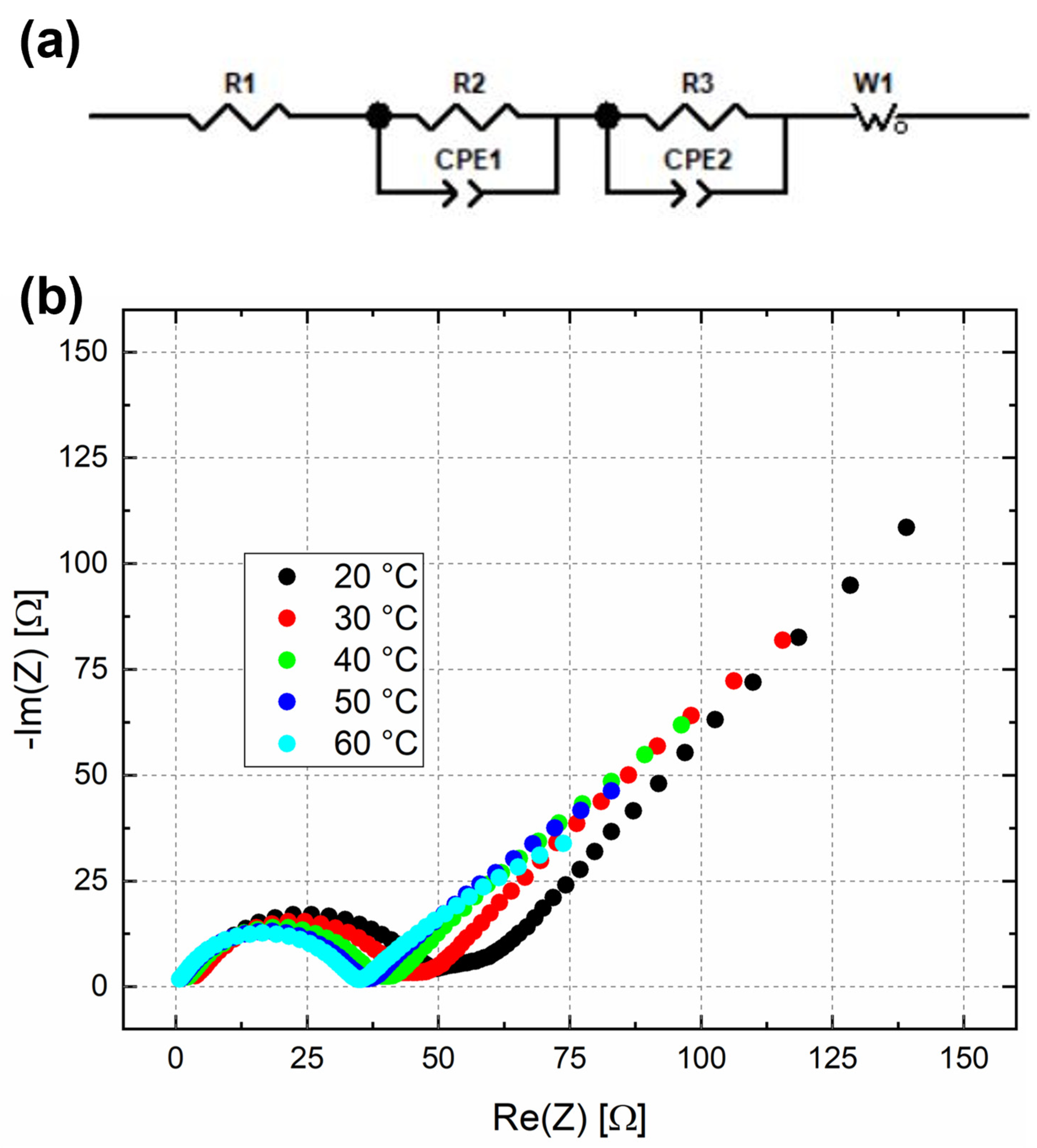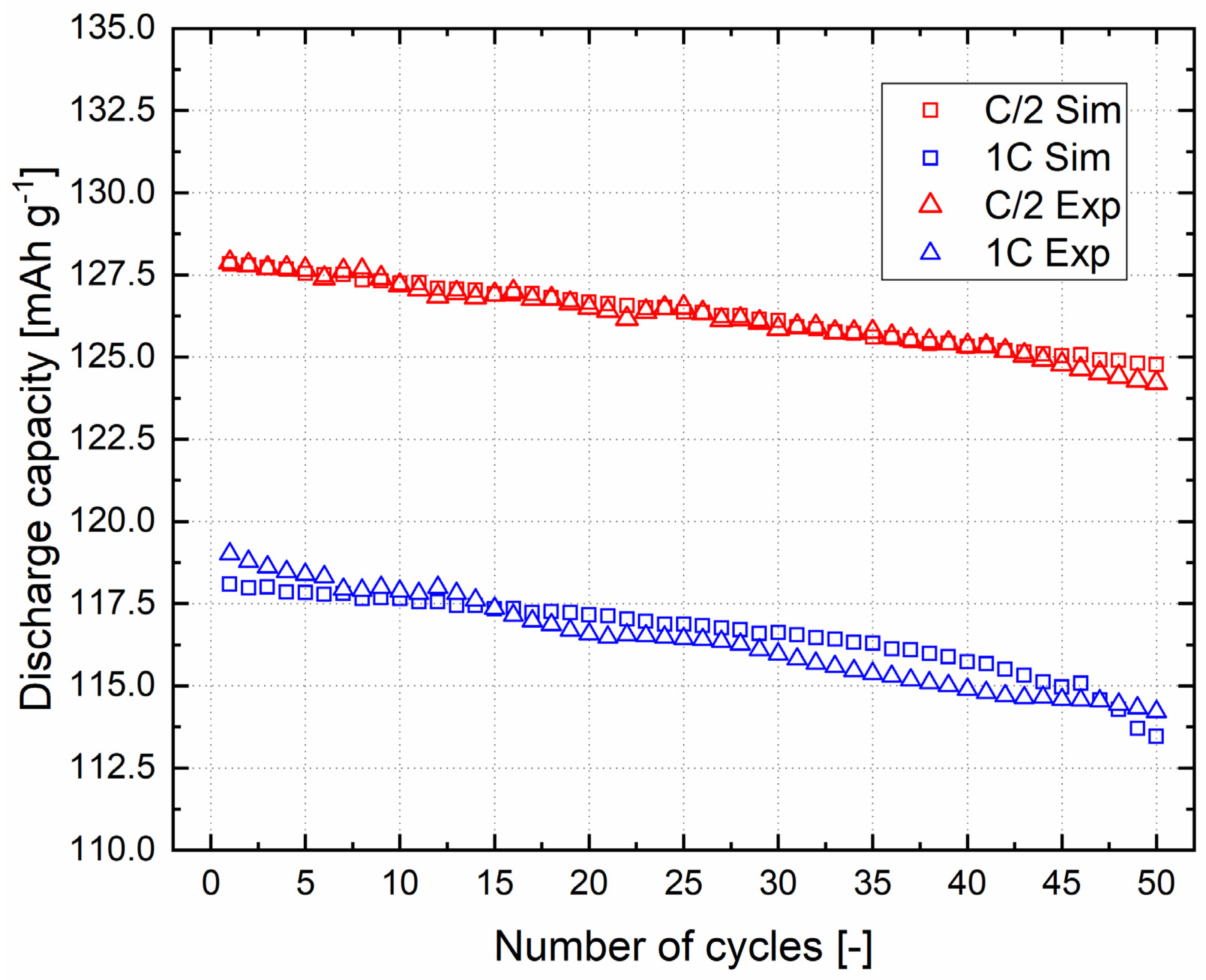Aging of a Lithium-Metal/LFP Cell: Predictive Model and Experimental Validation
Abstract
1. Introduction
2. Modeling
2.1. P2D Model
- (1)
- The boundary condition “ground”, corresponding to Equation (12), is applied to define a reference potential within the model. In the analysed case, this boundary condition is directly applied at the negative electrode of the cell, the metallic lithium, in order to define the cell voltage according to Equation (13).
- (2)
- The boundary condition “charge–discharge cycle” is applied at the extreme of the positive current collector to model the galvanostatic cycling behaviour of the cell. For the charge, a positive current and the maximum voltage (4 V) were employed, while for the discharge, a negative current and the minimum voltage (2 V) were applied.
2.2. Aging Implementation
3. Experimental Section
3.1. Electrode Preparation and Coin Cell Assembly
3.2. Electrochemical Characterization
3.3. Morphological Analysis
4. Results and Discussion
4.1. Experimental Results
4.1.1. Morphological Analysis
4.1.2. Equilibrium Potential Curve
4.1.3. Exchange Current Density
4.2. Model Calibration and Validation
4.2.1. Electrochemical Model Calibration and Validation
4.2.2. Aging Model Calibration and Validation
5. Conclusions
Supplementary Materials
Author Contributions
Funding
Data Availability Statement
Acknowledgments
Conflicts of Interest
Abbreviations
| av | Specific electrode surface |
| c | Volumetric concentration |
| D | Diffusivity |
| DFT | Density Functional Theory |
| Ecell | Cell voltage |
| Eeq | Equilibrium potential |
| EC:DEC | Ethylene carbonate:Dyethyl carbonate |
| EIS | Electrochemical Impedance Spectroscopy |
| EVs | Electric Vehicles |
| F | Faraday’s constant |
| f | Dependence activity |
| i | Current density |
| i0 | Reference exchange current density |
| k | Rate constant |
| Li2CO3 | Lithium carbonate |
| LiF | Lithium fluoride |
| LiPF6 | Lithium exafluorophosfate |
| LFP | Lithium iron phosphate |
| LIBs | Lithium-ion batteries |
| LMA | Lithium-metal anodes |
| LMBs | Lithium-metal batteries |
| M | Molar weight |
| MD | Molecular Dynamics |
| OCV | Open-Circuit Voltage |
| P2D | Pseudo-two-dimensional model |
| PEIS | Potentiostatic Electrochemical Impedance Spectroscopy |
| PVdF | Polyvinylidene fluoride |
| PF | Phase-field modeling |
| Q | Capacity |
| R | Universal gas constant |
| rp | Radius particle |
| RSEI | SEI Resistance |
| T | Temperature |
| t+ | Transference number |
| S | Electrode–electrolyte interface surface area |
| SEI | Solid Electrolyte Interphase |
| SoC | State of Charge |
| V | Voltage |
| Greek | |
| α | Charge transfer coefficient |
| δSEI | SEI Thickness |
| ε | Volumetric fraction |
| ρ | Density |
| η | Over-potential |
| σ | Conductivity |
| τ | Tortuosity |
| ϕ | Potential |
References
- Houache, M.S.E.; Yim, C.-H.; Karkar, Z.; Abu-Lebdeh, Y. On the Current and Future Outlook of Battery Chemistries for Electric Vehicles—Mini Review. Batteries 2022, 8, 70. [Google Scholar] [CrossRef]
- Ravi, S.S.; Aziz, M. Utilization of Electric Vehicles for Vehicle-to-Grid Services: Progress and Perspectives. Energies 2022, 15, 589. [Google Scholar] [CrossRef]
- Dik, A.; Omer, S.; Boukhanouf, R. Electric Vehicles: V2G for Rapid, Safe, and Green EV Penetration. Energies 2022, 15, 803. [Google Scholar] [CrossRef]
- Lemian, D.; Bode, F. Battery-Supercapacitor Energy Storage Systems for Electrical Vehicles: A Review. Energies 2022, 15, 5683. [Google Scholar] [CrossRef]
- Li, Z.; Khajepour, A.; Song, J. A Comprehensive Review of the Key Technologies for Pure Electric Vehicles. Energy 2019, 182, 824–839. [Google Scholar] [CrossRef]
- Sun, X.; Li, Z.; Wang, X.; Li, C. Technology Development of Electric Vehicles: A Review. Energies 2019, 13, 90. [Google Scholar] [CrossRef]
- Fichtner, M.; Edström, K.; Ayerbe, E.; Berecibar, M.; Bhowmik, A.; Castelli, I.E.; Clark, S.; Dominko, R.; Erakca, M.; Franco, A.A.; et al. Rechargeable Batteries of the Future—The State of the Art from a BATTERY 2030+ Perspective. Adv. Energy Mater. 2022, 12, 2102904. [Google Scholar] [CrossRef]
- Asenbauer, J.; Eisenmann, T.; Kuenzel, M.; Kazzazi, A.; Chen, Z.; Bresser, D. The Success Story of Graphite as a Lithium-Ion Anode Material–Fundamentals, Remaining Challenges, and Recent Developments Including Silicon (Oxide) Composites. Sustain. Energy Fuels 2020, 4, 5387–5416. [Google Scholar] [CrossRef]
- Zhao, L.; Ding, B.; Qin, X.; Wang, Z.; Lv, W.; He, Y.; Yang, Q.; Kang, F. Revisiting the Roles of Natural Graphite in Ongoing Lithium-Ion Batteries. Adv. Mater. 2022, 34, 2106704. [Google Scholar] [CrossRef]
- Shen, X.; Zhang, X.-Q.; Ding, F.; Huang, J.-Q.; Xu, R.; Chen, X.; Yan, C.; Su, F.-Y.; Chen, C.-M.; Liu, X.; et al. Advanced Electrode Materials in Lithium Batteries: Retrospect and Prospect. Energy Mater. Adv. 2021, 2021, 1–15. [Google Scholar] [CrossRef]
- Jiao, S.; Zheng, J.; Li, Q.; Li, X.; Engelhard, M.H.; Cao, R.; Zhang, J.G.; Xu, W. Behavior of Lithium Metal Anodes under Various Capacity Utilization and High Current Density in Lithium Metal Batteries. Joule 2018, 2, 110–124. [Google Scholar] [CrossRef]
- Waldmann, T.; Hogg, B.-I.; Wohlfahrt-Mehrens, M. Li Plating as Unwanted Side Reaction in Commercial Li-Ion Cells–A Review. J. Power Sources 2018, 384, 107–124. [Google Scholar] [CrossRef]
- Hu, D.; Chen, L.; Tian, J.; Su, Y.; Li, N.; Chen, G.; Hu, Y.; Dou, Y.; Chen, S.; Wu, F. Research Progress of Lithium Plating on Graphite Anode in Lithium-Ion Batteries. Chin. J. Chem. 2021, 39, 165–173. [Google Scholar] [CrossRef]
- Heiskanen, S.K.; Kim, J.; Lucht, B.L. Generation and Evolution of the Solid Electrolyte Interphase of Lithium-Ion Batteries. Joule 2019, 3, 2322–2333. [Google Scholar] [CrossRef]
- Vetter, J.; Novák, P.; Wagner, M.R.; Veit, C.; Möller, K.-C.; Besenhard, J.O.; Winter, M.; Wohlfahrt-Mehrens, M.; Vogler, C.; Hammouche, A. Ageing Mechanisms in Lithium-Ion Batteries. J. Power Sources 2005, 147, 269–281. [Google Scholar] [CrossRef]
- Wang, H.; Liu, Y.; Li, Y.; Cui, Y. Lithium Metal Anode Materials Design: Interphase and Host. Electrochem. Energy Rev. 2019, 2, 509–517. [Google Scholar] [CrossRef]
- Amici, J.; Calderón, C.A.; Versaci, D.; Luque, G.; Barraco, D.; Leiva, E.; Francia, C.; Bodoardo, S. Composite Polymer Electrolyte with High Inorganic Additive Contents to Enable Metallic Lithium Anode. Electrochim. Acta 2022, 404, 139772. [Google Scholar] [CrossRef]
- Ding, J.-F.; Zhang, Y.-T.; Xu, R.; Zhang, R.; Xiao, Y.; Zhang, S.; Bi, C.-X.; Tang, C.; Xiang, R.; Park, H.S.; et al. Review on Lithium Metal Anodes towards High Energy Density Batteries. Green Energy Environ. 2022; in press. [Google Scholar] [CrossRef]
- Wu, Z.; Kong, D. Comparative Life Cycle Assessment of Lithium-Ion Batteries with Lithium Metal, Silicon Nanowire, and Graphite Anodes. Clean Technol. Env. Policy 2018, 20, 1233–1244. [Google Scholar] [CrossRef]
- Lastoskie, C.M.; Dai, Q. Comparative Life Cycle Assessment of Laminated and Vacuum Vapor-Deposited Thin Film Solid-State Batteries. J. Clean Prod. 2015, 91, 158–169. [Google Scholar] [CrossRef]
- Ghazi, Z.A.; Sun, Z.; Sun, C.; Qi, F.; An, B.; Li, F.; Cheng, H.M. Key Aspects of Lithium Metal Anodes for Lithium Metal Batteries. Small 2019, 15, 1900687. [Google Scholar] [CrossRef] [PubMed]
- Wang, R.; Cui, W.; Chu, F.; Wu, F. Lithium Metal Anodes: Present and Future. J. Energy Chem. 2020, 48, 145–159. [Google Scholar] [CrossRef]
- Fang, C.; Li, J.; Zhang, M.; Zhang, Y.; Yang, F.; Lee, J.Z.; Lee, M.-H.; Alvarado, J.; Schroeder, M.A.; Yang, Y.; et al. Quantifying Inactive Lithium in Lithium Metal Batteries. Nature 2019, 572, 511–515. [Google Scholar] [CrossRef] [PubMed]
- Liu, B.; Zhang, J.G.; Xu, W. Advancing Lithium Metal Batteries. Joule 2018, 2, 833–845. [Google Scholar] [CrossRef]
- Li, B.; Wang, Y.; Yang, S. A Material Perspective of Rechargeable Metallic Lithium Anodes. Adv. Energy Mater. 2018, 8, 1702296. [Google Scholar] [CrossRef]
- Li, J.; Kong, Z.; Liu, X.; Zheng, B.; Fan, Q.H.; Garratt, E.; Schuelke, T.; Wang, K.; Xu, H.; Jin, H. Strategies to Anode Protection in Lithium Metal Battery: A Review. InfoMat 2021, 3, 1333–1363. [Google Scholar] [CrossRef]
- Barcellona, S.; Piegari, L. Lithium Ion Battery Models and Parameter Identification Techniques. Energies 2017, 10, 2007. [Google Scholar] [CrossRef]
- Zhao, Y.; Stein, P.; Bai, Y.; Al-Siraj, M.; Yang, Y.; Xu, B.X. A Review on Modeling of Electro-Chemo-Mechanics in Lithium-Ion Batteries. J. Power Sources 2019, 413, 259–283. [Google Scholar] [CrossRef]
- Adaikkappan, M.; Sathiyamoorthy, N. Modeling, State of Charge Estimation, and Charging of Lithium-Ion Battery in Electric Vehicle: A Review. Int. J. Energy Res. 2022, 46, 2141–2165. [Google Scholar] [CrossRef]
- Chen, Z.; Danilov, D.L.; Eichel, R.A.; Notten, P.H.L. Porous Electrode Modeling and Its Applications to Li-Ion Batteries. Adv. Energy Mater. 2022, 12, 2201506. [Google Scholar] [CrossRef]
- Doyle, M.; Fuller, T.F.; Newman, J. Modeling of Galvanostatic Charge and Discharge of the Lithium/Polymer/Insertion Cell. J. Electrochem. Soc. 1993, 140, 1526–1533. [Google Scholar] [CrossRef]
- Xu, L.; Lin, X.; Xie, Y.; Hu, X. Enabling High-Fidelity Electrochemical P2D Modeling of Lithium-Ion Batteries via Fast and Non-Destructive Parameter Identification. Energy Storage Mater. 2022, 45, 952–968. [Google Scholar] [CrossRef]
- Liu, K.; Gao, Y.; Zhu, C.; Li, K.; Fei, M.; Peng, C.; Zhang, X.; Han, Q.L. Electrochemical Modeling and Parameterization towards Control-Oriented Management of Lithium-Ion Batteries. Control Eng. Pract. 2022, 124, 105176. [Google Scholar] [CrossRef]
- Sahapatsombut, U.; Cheng, H.; Scott, K. Modelling the Micro-Macro Homogeneous Cycling Behaviour of a Lithium-Air Battery. J. Power Sources 2013, 227, 243–253. [Google Scholar] [CrossRef]
- Sahapatsombut, U.; Cheng, H.; Scott, K. Modelling of Operation of a Lithium-Air Battery with Ambient Air and Oxygen-Selective Membrane. J. Power Sources 2014, 249, 418–430. [Google Scholar] [CrossRef]
- Kumaresan, K.; Mikhaylik, Y.; White, R.E. A Mathematical Model for a Lithium–Sulfur Cell. J. Electrochem. Soc. 2008, 155, A576. [Google Scholar] [CrossRef]
- Zhang, T.; Marinescu, M.; Walus, S.; Offer, G.J. Modelling Transport-Limited Discharge Capacity of Lithium-Sulfur Cells. Electrochim. Acta 2016, 219, 502–508. [Google Scholar] [CrossRef]
- Wu, H.; Jia, H.; Wang, C.; Zhang, J.G.; Xu, W. Recent Progress in Understanding Solid Electrolyte Interphase on Lithium Metal Anodes. Adv. Energy Mater. 2021, 11, 2003092. [Google Scholar] [CrossRef]
- Ramasubramanian, A.; Yurkiv, V.; Foroozan, T.; Ragone, M.; Shahbazian-Yassar, R.; Mashayek, F. Stability of Solid-Electrolyte Interphase (SEI) on the Lithium Metal Surface in Lithium Metal Batteries (LMBs). ACS Appl. Energy Mater. 2020, 3, 10560–10567. [Google Scholar] [CrossRef]
- Cheng, X.B.; Zhang, R.; Zhao, C.Z.; Wei, F.; Zhang, J.G.; Zhang, Q. A Review of Solid Electrolyte Interphases on Lithium Metal Anode. Adv. Sci. 2015, 3, 1500213. [Google Scholar] [CrossRef]
- Lin, Y.; Zhang, X.; Liu, Y.; Wang, Q.; Lin, C.; Chen, S.; Zhang, Y. Ultra-Stable Li||LiFePO4 Batteries via Advanced Designing of Localized High Concentration Electrolyte. J. Colloid Interface Sci. 2022, 628, 14–23. [Google Scholar] [CrossRef]
- Pron, V.G.; Versaci, D.; Amici, J.; Francia, C.; Santarelli, M.; Bodoardo, S. Electrochemical Characterization and Solid Electrolyte Interface Modeling of LiNi 0.5 Mn 1.5 O 4 -Graphite Cells. J. Electrochem. Soc. 2019, 166, A2255–A2263. [Google Scholar] [CrossRef]
- Jokar, A.; Rajabloo, B.; Désilets, M.; Lacroix, M. Review of Simplified Pseudo-Two-Dimensional Models of Lithium-Ion Batteries. J. Power Sources 2016, 327, 44–55. [Google Scholar] [CrossRef]
- Franke-Lang, R.; Kowal, J. Electrochemical Model-Based Investigation of Thick LiFePO4 Electrode Design Parameters. Modelling 2021, 2, 259–287. [Google Scholar] [CrossRef]
- Liu, D.; He, Y.; Chen, Y.; Cao, J.; Zhu, F. Electrochemical Modeling, Li Plating Onsets and Performance Analysis of Thick Graphite Electrodes Considering the Solid Electrolyte Interface Formed from the First Cycle. Electrochim. Acta 2023, 439, 141651. [Google Scholar] [CrossRef]
- Kindermann, F.M.; Keil, J.; Frank, A.; Jossen, A. A SEI Modeling Approach Distinguishing between Capacity and Power Fade. J. Electrochem. Soc. 2017, 164, E287–E294. [Google Scholar] [CrossRef]
- Appiah, W.A.; Busk, J.; Vegge, T.; Bhowmik, A. Sensitivity Analysis Methodology for Battery Degradation Models. Electrochim. Acta 2023, 439, 141430. [Google Scholar] [CrossRef]
- Lamorgese, A.; Mauri, R.; Tellini, B. Electrochemical-Thermal P2D Aging Model of a LiCoO2/Graphite Cell: Capacity Fade Simulations. J. Energy Storage 2018, 20, 289–297. [Google Scholar] [CrossRef]
- Chen, S.-P.; Lv, D.; Chen, J.; Zhang, Y.-H.; Shi, F.-N. Review on Defects and Modification Methods of LiFePO 4 Cathode Material for Lithium-Ion Batteries. Energy Fuels 2022, 36, 1232–1251. [Google Scholar] [CrossRef]
- Li, J.; Cheng, Y.; Jia, M.; Tang, Y.; Lin, Y.; Zhang, Z.; Liu, Y. An Electrochemical-Thermal Model Based on Dynamic Responses for Lithium Iron Phosphate Battery. J. Power Sources 2014, 255, 130–143. [Google Scholar] [CrossRef]
- Chen, C.-H.; Brosa Planella, F.; O’Regan, K.; Gastol, D.; Widanage, W.D.; Kendrick, E. Development of Experimental Techniques for Parameterization of Multi-Scale Lithium-Ion Battery Models. J. Electrochem. Soc. 2020, 167, 080534. [Google Scholar] [CrossRef]
- Wildfeuer, L.; Gieler, P.; Karger, A. Combining the Distribution of Relaxation Times from EIS and Time-Domain Data for Parameterizing Equivalent Circuit Models of Lithium-Ion Batteries. Batteries 2021, 7, 52. [Google Scholar] [CrossRef]
- Amin, R.; Belharouak, I. Part-II: Exchange Current Density and Ionic Diffusivity Studies on the Ordered and Disordered Spinel LiNi 0.5 Mn 1.5 O 4 Cathode. J. Power Sources 2017, 348, 318–325. [Google Scholar] [CrossRef]
- Lee, H.; Yang, S.; Kim, S.; Song, J.; Park, J.; Doh, C.H.; Ha, Y.C.; Kwon, T.S.; Lee, Y.M. Understanding the Effects of Diffusion Coefficient and Exchange Current Density on the Electrochemical Model of Lithium-Ion Batteries. Curr. Opin. Electrochem. 2022, 34, 100986. [Google Scholar] [CrossRef]





| Temperature (°C) | |||||
|---|---|---|---|---|---|
| 20 | 30 | 40 | 50 | 60 | |
| (Ω) | 47.83 | 40.88 | 37.10 | 35.25 | 34.04 |
| (A m−2) | 2.99 | 3.62 | 4.11 | 4.47 | 4.77 |
| Parameter | Negative Electrode | Positive Electrode | Separator | Aluminium |
|---|---|---|---|---|
| Design specifications (geometry and volume fraction) | ||||
| Acell (m2) | 0.000177 | |||
| Li (μm) | 28 | 25 | 22 | |
| Ri (μm) | 1 | |||
| εs | 0.195 | |||
| εl,i 1 | 0.332 | 0.54 | ||
| Lithium ion concentration | ||||
| cs,max (mol m−3) 2 | 21,190 | |||
| cs,ini (mol m−3) | 21,190 × 0.999 | |||
| Kinetic and transport properties | ||||
| αa,i, αc,i | 0.5 | 0.5 | ||
| σi (S m−1) 2 | 91 | 3.77 × 107 | ||
| Di (m2 s−1) 2 | 3.2 × 10−13 | |||
| Constant quantity | ||||
| T (K) | 293.15 | |||
| F (C mol −1) | 96,487 | |||
| R (J mol −1 K −1) | 8.314 | |||
Disclaimer/Publisher’s Note: The statements, opinions and data contained in all publications are solely those of the individual author(s) and contributor(s) and not of MDPI and/or the editor(s). MDPI and/or the editor(s) disclaim responsibility for any injury to people or property resulting from any ideas, methods, instructions or products referred to in the content. |
© 2023 by the authors. Licensee MDPI, Basel, Switzerland. This article is an open access article distributed under the terms and conditions of the Creative Commons Attribution (CC BY) license (https://creativecommons.org/licenses/by/4.0/).
Share and Cite
Dessantis, D.; Di Prima, P.; Versaci, D.; Amici, J.; Francia, C.; Bodoardo, S.; Santarelli, M. Aging of a Lithium-Metal/LFP Cell: Predictive Model and Experimental Validation. Batteries 2023, 9, 146. https://doi.org/10.3390/batteries9030146
Dessantis D, Di Prima P, Versaci D, Amici J, Francia C, Bodoardo S, Santarelli M. Aging of a Lithium-Metal/LFP Cell: Predictive Model and Experimental Validation. Batteries. 2023; 9(3):146. https://doi.org/10.3390/batteries9030146
Chicago/Turabian StyleDessantis, Davide, Piera Di Prima, Daniele Versaci, Julia Amici, Carlotta Francia, Silvia Bodoardo, and Massimo Santarelli. 2023. "Aging of a Lithium-Metal/LFP Cell: Predictive Model and Experimental Validation" Batteries 9, no. 3: 146. https://doi.org/10.3390/batteries9030146
APA StyleDessantis, D., Di Prima, P., Versaci, D., Amici, J., Francia, C., Bodoardo, S., & Santarelli, M. (2023). Aging of a Lithium-Metal/LFP Cell: Predictive Model and Experimental Validation. Batteries, 9(3), 146. https://doi.org/10.3390/batteries9030146









